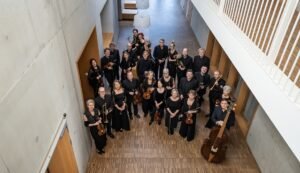SATURDAY, 22 h
24/08/2024
FREIBURGER BAROCKORCHESTER
Gottfried VON DER GOLTZ, concertmaster
Kristian BEZUIDENHOUT, fortepiano
MOZART!


PROGRAM
Simfonia núm. 29 en la major K. 201 (1774)
W. A. Mozart (1756-1791)
I. Allegro moderato
II. Andante
III. Menuetto: Allegretto
IV. Trio
V. Allegro con spirito
Concert per a piano núm. 17 en sol major K. 453 (1784)
W. A. Mozart (1756-1791)
I. Allegro
II. Andante
III. Allegretto
PAUSA
Simfonia en sol menor op. 6 No. 6 W.C. 12 (1770)
J. C. Bach (1735-1782)
I. Allegro
II. Andante più tosto adagio
III. Allegro molto
Concert per a piano núm. 9 en mi bemoll major «Jenamy»* K. 271 (1777)
W. A. Mozart (1756-1791)
I. Allegro
II. Andantino
III. Rondeau. Presto
Freiburger Barockchester
Passion, joy of playing, authenticity – these are the musical cornerstones of the Freiburg Baroque Orchestra (FBO). For more than three decades, the FBO has been one of the world’s leading original sound ensembles, performing over 100 concerts a year in Germany and abroad.
The orchestra was founded by a group of graduates of the Freiburg University of Music with the aim of performing historically informed music of the Baroque and Classical periods. historically informed. International engagements soon followed and the FBO quickly advanced to become one of the most one of the most sought-after ensembles on the early music scene. This success is due to more than 130 recordings, some of them award-winning.
In addition to its own subscription series in Freiburg, Stuttgart and Berlin, the FBO performs in the world’s leading concert halls, including the Lincoln Center New York, the Elbphilharmonie, the Musikverein Vienna and the Philharmonie de Paris. The FBO is also a popular guest at international festivals such as the Salzburg Festival, the Rheingau Music Festival and the Gstaad Menuhin Festival.
Musical responsibility for the orchestra lies with Cecilia Bernardini and Gottfried von der Goltz, who lead the ensemble from the violin. In the spirit of historically informed performance practice, the FBO usually performs without a conductor. For selected programs, e.g. for opera productions or romantic symphonies, the orchestra works with renowned conductors such as Pablo Heras-Casado, René Jacobs and Sir Simon Rattle. The FBO has close musical friendships with Kristian Bezuidenhout, Isabelle Faust, Dorothee Mields, Vox Luminis, the Zürcher Sing-Akademie and the RIAS Kammerchor Berlin.
In the 2023/24 season, the orchestra will once again showcase its wide stylistic range. It will perform Charpentier’s Medée under Sir Simon Rattle at the Staatsoper Unter den Linden in Berlin, Bach’s St. Matthew Passion with Philippe Jaroussky in France, Spain and Korea and works by Mendelssohn and Brahms at the Leipzig Bach Festival together with the Gaechinger Cantorey and Hans-Christoph Rademann.
Kristian Bezuindehout
Kristian Bezuidenhout is one of today´s most notable and exciting keyboard artists, equally at home on the fortepiano, harpsichord, and modern piano.
He is Artistic Director of the Freiburger Barockorchester and Principal Guest Director with the English Concert. He is a regular guest with the world´s leading ensembles including Les Arts Florissants, Orchestra of the Age of Enlightenment, orchestre des Champs Elysées, Koninklijk Concertgebouworkest, Chicago Symphony Orchestra & the Leipzig Gewandhausorchester; and has guest – directed (from the keyboard) the Orchestra of the Eighteenth Century, Tafelmusik, Collegium Vocale, Juilliard 415, Kammerakademie Potsdam and Dunedin Consort.
He has performed with celebrated artists including John Eliot Gardiner, Philippe Herreweghe, Frans Brüggen, Trevor Pinnock, Giovanni Antonini, Jean-Guihen Queyras, Isabelle Faust, Alina Ibragimova, Rachel Podger, Carolyn Sampson, Anne Sofie von Otter, Mark Padmore & Matthias Goerne.
Kristian´s rich and award-winning discography on Harmonia Mundi includes the complete keyboard music of Mozart (Diapason d´Or de L´année, Preis der Deutschen Schallplattenkritik & Caecilia Prize); Mozart Violin Sonatas with Petra Müllejans; Mendelssohn and Mozart Piano Concertos with the Freiburger Barockorchester (ECHO Klassik); Beethoven & Mozart Lieder, and Schumann Dichterliebe with Mark Padmore (Edison Award). In 2013 he was nominated as Gramophone Magazine´s Artist of the Year and was awarded the «Wiener Flötenuhr» by the Mozartgemeinde Wien in 2019 for his recordings of Mozart´s keyboard music.
Recent releases include Winterreisse with Mark Padmore, Bach sonatas for violin and harpsichord with Isabelle Faust, a recording of Haydn piano sonatas and Beethoven´s piano concertos with the Freiburger Barockorchester and Pablo Herás-Casado.
It is time for gallantry, sentimentality and simplicity
Bàrbara Duran Bordoy
One of the drivers that help classify artworks is their inclusion within a specific time frame marked by a style. This classification, which becomes standard and known to everyone, is often discussed by the very historians. It is not easy to grasp which elements should be prioritised or highlighted in a specific historical style. Still, the fact remains that doing so benefits the appreciation of the musical piece as a whole.
In that sense, the 18th century is one of the most complex. Initially considered as an aesthetically sectioned century—baroque until 1750, classicism henceforth—the latest historical contributions consider that it actually began with the baroque heyday. However, new trends such as the Galant style, which emerged after 1720 and culminated in the rise of classicism around 1780, set aesthetic changes.
The pieces scheduled tonight are part of the verge between this 18th-century core period of the very classicism.
Symphony No. 29 opening theme draws on the Galant style’s conventional melodic formulas. Mozart (1751 – 1791) displays a finesse that is challenging to find in an eighteen-year-old composer. This is simply down to the symphony reflecting a seemingly fortuitous neatness but being part of an already unique musical individuality. Mozart minds here the slight appearance of the wind instruments, which makes us realise he did not just consider them to double the strings’ voices.
Concert No. 17 in G major opens with a pretty particular energy found in many of Mozart’s works, just as the finest embroidery of his piano language. This is the concert where a passionate commitment and the use of expressiveness—not found as clearly in Symphony No. 29, composed ten years earlier—are also identified.
These ten years mark the consolidation of the Sturm und Drang—«storm and impetus»—as one of the aesthetic currents paramount to comprehending the 18th century, revealing the signs of early romanticism: the stormy, sensitive and delicate feeling. However, Sturm und Drang has been reached through an evolution of the Galant style, which introduces the Empfindsamkeit or sentimental music, to wit an even more intimate and plain form than the Galant style spirit—the recovery of a particular technical and formal plainness, prompted by a new audience: the bourgeois enthusiasts.
Thus, the Baroque’s final stages, the Galant style, the Empfindsamkeit and the Sturm un Drang, are interlinked, leading towards romanticism. One of the best-known representatives of the Galant style is Johann Christian Bach (1735 – 1782), the youngest son of J. S. Bach, who developed much of his career in London. In 1764, he met an eight-year-old Mozart there, over whom he reportedly greatly influenced adopting the Galant style. It is difficult to assess the impact of J. Bach on Mozart, but the latter admittedly held him in great esteem. Nannerl Mozart tells how much fun they had making music together in London.
In any case, this Symphony in G minor op. 6 no. 6 draws on a minor key, rare in the symphonies within that period. J. C. Bach explores the strings’ timbre in the opening movement’s violins and violas’ fast sequences and the second movement’s cellos’ brief embellishment. He also explores a somewhat mysterious atmosphere. The sweet figures of two tied notes in the form of a light sigh are present in a significant part of the melodic design. However, one of this symphony’s most interesting facets is this timbral investigation and the exploration of the orchestra’s joint expressiveness.
We cannot ignore another aesthetic movement present in this concert: performance with a historicist approach. Listening to the two Mozartian concerts performed with a fortepiano allows us to place ourselves in the mid-18th century much better than the descriptions of the stylistic movements. Still, Mozart goes his own way: in Piano Concerto No. 9, «Jenamy,» the soloist’s opening and the dialogues between the soloist and the orchestra are well ahead of their time and already point to the piano concerts of romanticism.
Elogiada per la qualitat dels seus músics i per ser un conjunt versàtil capaç d’interpretar amb admirable personalitat tant òpera com música líricosimfònica, l’OCV continua la seua trajectòria professional impulsada per primeres figures de la direcció orquestral, entre les quals hi ha Daniele Gatti, Fabio Luisi o Antonello Manacorda, i amplia el seu repertori operístic de la mà de reconegudes batutes internacionals especialitzades en diferents estils, com Marc Albrecht, Maurizio Benini, Cornelius Meister, Riccardo Minasi i Marc Minkowski. A més, afiança la col·laboració amb els principals directors espanyols que més projecció tenen fora de les nostres fronteres, entre ells Gustavo Gimeno, Pablo Heras-Casado, Juanjo Mena i Josep Pons.
SPONSORS

FINANCED BY


WITH THE SUPPORT OF

OFFICIAL MEDIA

